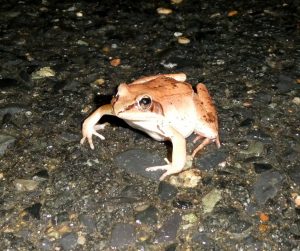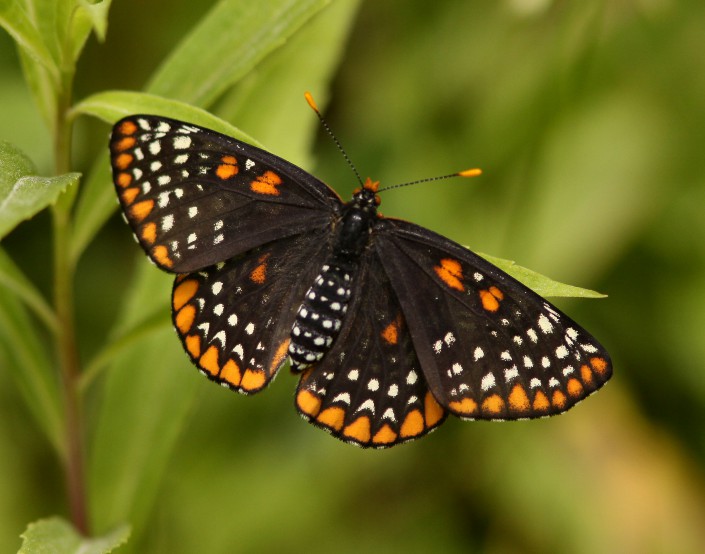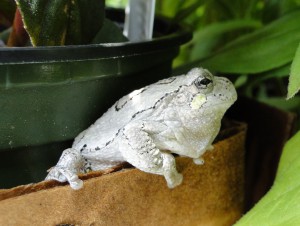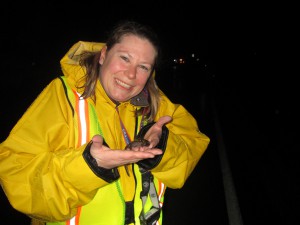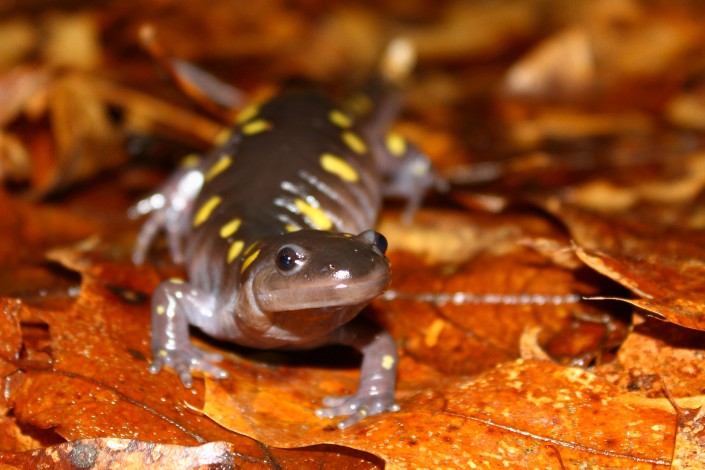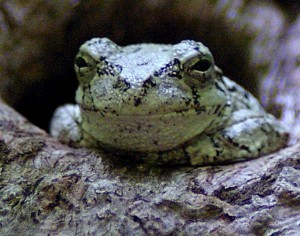Raising Awareness for Amphibians
by Christine Healy, Wildlife Biologist
Supporters who follow Conserve Wildlife Foundation across our social media platforms may have noticed that our channels became a bit less feather-y and more froggy in early May. This “takeover” was not just an acknowledgment of frogs and salamanders resuming their activities after winter brumation; however, you can expect the greatest diversity in the evening chorus this month with all native species besides mid-Atlantic coast leopard and wood frogs regularly calling. Rather, our shift in theme was in support of two international campaigns, Salamander Saturday and Amphibian Week, which aim to raise awareness for the most globally threatened class of vertebrates.
The Foundation for the Conservation of Salamanders (FCSal) began the Salamander Saturday initiative in 2015 and has annually encouraged other organizations around the world to help “Keep the World Slimy” through outreach events. This year, several zoos, nature centers, parks, museums, and even a brewery joined in the festivities by offering interactive exhibits, walks, crafts, and more for their patrons on May 4th. In addition to live activities, FCSal urges the use of #SalamanderSaturday on Facebook and Instagram to disseminate information far and wide.
While CWF’s work focuses on large-bodied mole salamanders, New Jerseyans are lucky enough to share the landscape with 16 species ranging from the tiny four-toed salamander (~2”) to the Eastern tiger salamander (~8”). Of these, nine are currently being monitored as endangered, threatened, species of concern, or species of interest, largely due to habitat loss and fragmentation. While you may not see them often, salamanders do a lot for our planet. They play an important role in the food chain as both predator and prey, contribute to carbon sequestration, aerate the soil, and more. Salamanders are also fascinating creatures. Though they do not coexist peacefully within flames as myths and legends suggest, they do share something in common with embers in that they “glow”. Scientists have not cracked the code on why but have found that many species bio fluoresce under different wavelengths of light. The bright colors and patterns frequently featured on their skin can be indicative of toxins and they are experts in regeneration, which could hold clues for medical advancement. Check out the infographic we created for this year’s celebration.

Amphibian Week was started by the Partners in Amphibian and Reptile Conservation (PARC) in 2020 and spans the first full week of May each year (the 5th– 11th in 2024). Activities occur in virtual and live capacities but are inspired by a unique theme that is selected in advance by PARC. In recognition of the upcoming summer Olympics in Paris, this year’s concept was Extreme Athletes: Amphibian Edition. Daily prompts included an opening ceremony, a warm-up day, aquatic, gymnastic, and track & field “events”, awards, and a closing ceremony.
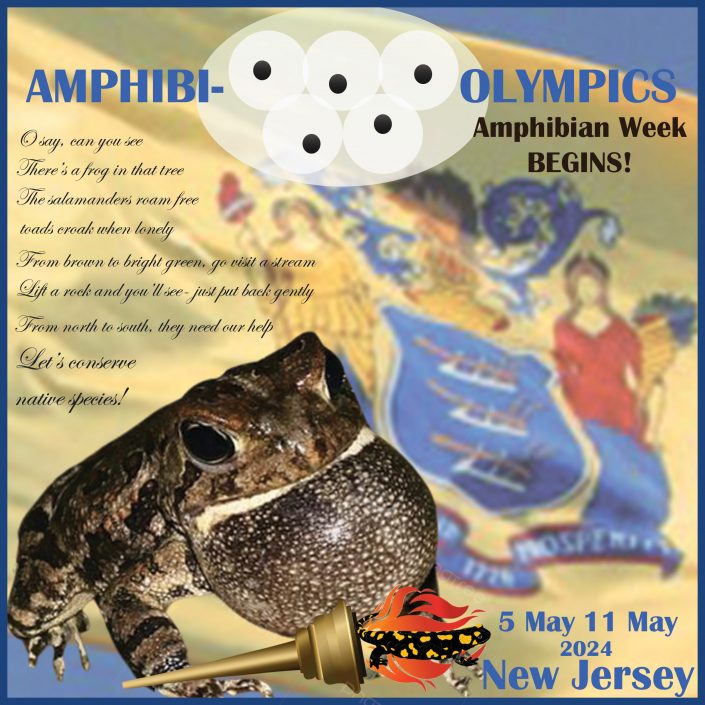
CWF interns, Connor and Nikki, had fun getting creative with the theme and sharing all the knowledge and admiration that they have for frogs and salamanders with our followers on Facebook and Instagram during our Amphibi-Olympics. After an evaluation of the adaptations our native amphibians have evolved to excel at life in water, on land, and in the trees, the bullfrog, Pine Barrens tree frog, and spring peeper took home the gold in the aforementioned “sports”. To add to the fun (and to accurately represent our life in the field where dad-jokes are applauded), each day included an amphibious pun. See our social media (@wildlifenj) for all the knee-slappers but here’s a curated selection:
- What do you call a hard-working female carpenter frog? Rosie the Ribbiter!
- Why was the Eastern spadefoot late to work? His vehicle was toad!
- What did the frog driving school instruct their students before getting behind the wheel? Cricket or Ticket!

While Salamander Saturday and Amphibian Week are fun and entertaining excuses to share the trivia and photos we amass throughout our field seasons, they are rooted in a not-so-fun and entertaining truth: over 40% of amphibians worldwide are currently on a path toward extinction. The amazing adaptations that enable them to inhabit both water and land make them more sensitive than other types of wildlife to changes in our environment… and our environment is changing. Decline is rapid and very concerning. But you can help! Become an Amphibian Ally by instituting small changes that can add up. Here are some ideas:
- Drive cautiously during the migration seasons.
- Leave piles of leaf litter around in the fall.
- Reduce the use of chemical fertilizers and pesticides you apply on your property- they can change the chemistry of breeding pools and reduce or eliminate reproductive potential.
- Enjoy ATVs on trails – not by driving through pools and puddles!
- Celebrate amphibians from a respectful distance unless you are actively assisting one in crossing a road or have to touch them for scientific research.
- Report rare sightings and any sightings that occur on roadways to NJDEP’s Wildlife Tracker App: https://survey123.arcgis.com/share/ae6c1dbdacd94562a25785433f612750
- Spend time hiking along streams/fishing? Decontaminate your shoes and gear to prevent the spread of diseases. Check out PARC’s guide on how: https://www.youtube.com/watch?v=ax6dx72xOCQ
- Talk about amphibians! Educate your friends, family members, students, neighbors, etc.
- Interested in donating toward conservation efforts? Consider specifying amphibians as the beneficiaries as they are incredibly difficult to find grant funding for.
Want to learn more? In addition to following along with CWF’s work, PARC is a fantastic resource to stay up to date on amphibian and reptile news. Sign up for their newsletter here: https://parcplace.org/network/join-parc/

Every week is Amphibian Week for our Herp team. We’re grateful to FCSal and PARC for putting a larger spotlight on these animals and to all of you, who took the time to learn and spread the message this month.


